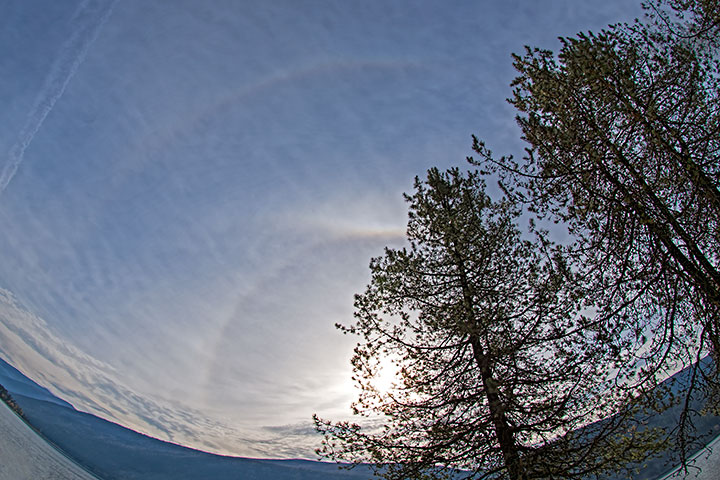This morning’s haloes, forming over the Lake, might have been expected. After all, a storm is moving towards us and is expected to bring rain overnight and tomorrow. Often such events are presaged by a canopy of cirrus, which is just the thing to give haloes. Yet the sequence of a halo preceding a storm, while common on the Coast, is not all that common around here.
The appearance of these circles, arcs and spots in the sky requires the ice crystals to have simple shapes. The stellar crystals, beloved of shop decorators around Christmas, just don’t do it. Rather, what is needed is either a hexagonal column (somewhat like a wooden pencil with a hexagonal cross section), or a thin slice through that (somewhat like a hexagonal dinner plate). The growth of these shapes results from the small supersaturations that are characteristic of the slowly ascending air found as a storm approaches from the ocean. The more chaotic air motion over the mountains seems to favour higher supersaturations and the more complex crystal forms.
Sometimes we do see the simple crystal forms in the sky. What was interesting about this morning’s haloes was that they only resulted from columnar crystals, not plates. Which form appears depends not only on the humidity, but also the temperature in the cloud.
In the scene, below, the 22° halo is the smaller one centred on the Sun. It is formed by quite small crystals that assume a wide range of orientations as a result of the Brownian motion in the air. Sunlight passing through the 60° prisms presented by alternative crystal sides is deviated by a minimum angle of about 22° to give the halo. As the columnar crystals grow larger they become horizontally oriented by aerodynamic forces during their descent. These crystals give the upper tangential arc that appears as the bird wings touching the top of the 22° halo.
At about twice the distance from the Sun as the 22° halo is another one. This is explained by sunlight refracting through the 90° prism ends of columnar crystals. If these crystals were small and assumed a wide range of orientations, they would produce the 46° halo. It is more likely that what we are seeing is the result of larger columnar crystals producing the supralateral tangential arc.
Be that as it may, the features that would be caused by hexagonal plate crystals — sundogs, circumzenithal arc — are missing. To see a posting with some of these other features, visit celestial splendour.


Fabulous post, Alistair. You make it all so crystal clear, so to speak.
Best wishes
As a weather observer for 35 years i would say the halo’s or in this case arks are formed
in a layer of Cirostratus that is above the cirocumulus or high altocumulus that you can see.
Halo’s are only formed in cirostratus as you are stating that is cloud formed by the type of crystals
you have explained.
Wesley, you are right that the haloes shown are forming in a layer of cirrostratus. It is the broad, slow ascent of the air producing the cirrostratus that gives a uniform layer of simple crystals. However, this isn’t the only cloud composed of ice crystals that can cause haloes. They can also be seen in ice fogs, fallstreaks, and sometimes in the outflow of a thunderstorm anvil. Curiously, they have been seen in the crystals that drift away from the snow makers on ski hills. Haloes have even been seen in hoar frost that formed atop a snow pack. Needed are merely the right light and type of crystals.